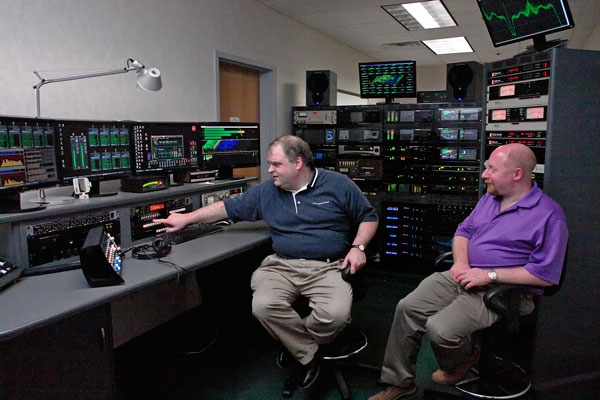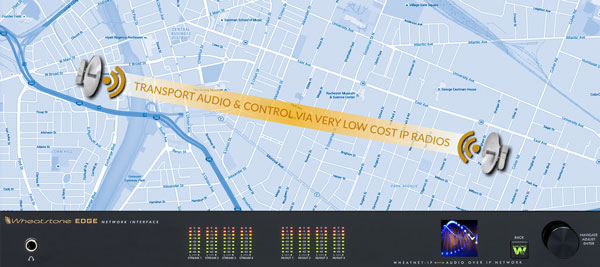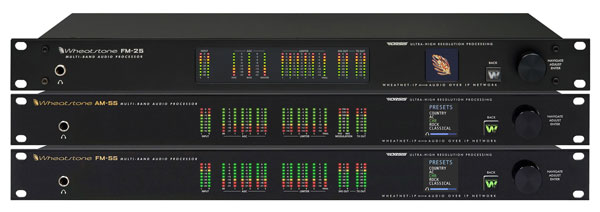WHEAT:NEWS Radio March 2016 - Vol 7, No. 3
Got feedback or questions? Click my name below to send us an e-mail. You can also use the links at the top of the page to follow us on popular social networking sites and the tabs will take you to our most often visited pages.
Fybush on Translators
What could these two be talking about? Mike Erickson, left, and Scott Fybush.
Here’s another one that falls under the heading of You Might Be a Broadcaster If. Only in broadcasting do we use the words FM translator and AM in the same sentence without thinking that’s even a little bit strange. As an industry, we’ve long wrapped our minds around the idea that FM translators could be the next step forward in the AM Revitalization initiative. You could even say that some of us are evangelical about it. The name Scott Fybush comes to mind.
There is perhaps no one more dedicated to reviving AM than Scott Fybush, who participated in the AM Revitalization proceedings and is now working with AM broadcasters to sort through the details of acquiring and implementing FM translators. Scott is a longtime broadcaster and a self-described industry observer, who, by the way, travels around the country taking pictures of radio antennas and thinks nothing is strange about that.
We were able to spend a few minutes talking with Scott about translators during his recent swing through New Bern, when he stopped in to see fellow CBS alumnus Mike Erickson and to get a tour of our factory. Here’s what he had to say.
WS: We’ve been watching the filings. It’s now less than three weeks into it, and there have been 462 applications filed, 142 (FM translators for AM revitalization) granted. This was just the so-called 250-mile filing, which essentially gives Class Cs and some Ds the opportunity to relocate certain FM translators. But that’s just the first of, what, three windows?
SF: Right. Class Cs and Ds got their 250-mile modification window starting January 29. Next are the Class B filings, and their window starts in July. And what’s left after that is they’re opening up a window for brand new filings sometime in early 2017. So if you’re lucky to be somewhere where they still have open channels, you can file at that point without having to pay someone to move a translator. But, if you’re in a market that has only one or two available channels, it’s a gamble because you don’t know yet what Class Ds are going to do and if you’re a Class D, you don’t know what is going to get filed as a new C or D application. It’s kind of like a poker game.
WS: That's an interesting poker game, too, because we understand that the majority of filings happened the first day.
SF: Yes. The really wild part is that station groups who own translators are able to move them themselves because of this. iHeart, for instance, applied for a bunch of translators in 2003 without any real plan of what to do with them. So, they were ready on the first day of the window and they filed a whole bunch of moves so they could relocate translators to places where they have AMs.
WS: There were a lot of translators licensed over the years but not built out. Do we have any idea how many FM translators are owned by FM broadcasters but not in use and possibly up for grabs by AM broadcasters now?
SF: The last number I saw was like 6,000 translators that are in CP stage right now. That’s a lot. The original idea when they first licensed FM translators in the early 70s was to provide service mainly out West where there was no service and they couldn’t afford an FM. People filed because the theory was that was going to be the last chance. In some cases, they found they didn’t need all the translators they filed for or it didn’t make much sense financially, especially in the Northeast where the pricing was so high. So now, if you got an FM translator in a small town, do you hang onto it or do you get $75,000 or $80,000 for it?
WS: So, if we have 6,000 CPs and who-knows-how-many other available translators out there, FM broadcasters have to be a little concerned there’s going to be congestion on their band.
SF: That’s another piece of this. One thing I remind everyone that buys a translator is that they’re buying a secondary service. You can be bumped off the dial because of interference, which is why it’s important to try to look ahead and make sure there’s not going to be interference problems.
WS: What else do AM broadcasters need to consider as they’re thinking about putting up an FM translator?
SF: You’re limited in interference (to adjacent stations) but you’re also limited by the existing radius of your AM. This is something that as we get to the next round of the rulemaking, it’ll be interesting to see what the FCC does. Right now, your translator has to stay within the 2-millivolt contour (2 mV/m) of your AM or within 25 miles, or the lesser of the two. It doesn’t matter how big your AM is, you’re never going to get more than 25 miles of where your AM transmitter is. If you have AM in a directional pattern, like one I know of in Long Island Sound, you’re very limited as to where to put that translator because although there are a lot of places that need to be served, they’re not within the 2-millivolt contour of the AM. We’re going to be watching to see what the changes are and if there are immediate opportunities to open up an AM signal with a translator.
WS: Explain the FCC’s ruling on antenna height.
SF: Another interesting quirk is that it is 250 Watts (power) with no limitations on antenna height. So there are translators up in Sandia Crest that are running 250 Watts from 2,000 feet above Albuquerque. That’s not only bigger than a Class A, it’s bigger than a Class C would be there. That doesn’t work everywhere, but it sure works there and in a few other places.
WS: What are the costs associated with this? We’ve been talking to broadcasters about using IP radios with our WheatNet-IP system to make the 25-mile hop from the studio to the translator. These start at a couple hundred dollars for a system, so the price is right. Cost has to be a huge consideration for these AM broadcasters.
SF: Cost is a big part of this, especially in the Northeast, where so many broadcasters would love to do this but can’t afford to even get the CP. In some cases, a CP can run $100,000 or more. And then there’s the equipment. For a decent transmitter, you’re looking at $5,000 to $10,000 minimum. You got antenna costs, and in some cases you have rental costs associated with where the antenna is located. So, yes, something like WheatNet-IP into an Ubiquity radio is very useful. I expect we’ll see a lot of unlicensed 5.8 Ubiquity radios used for this.
WS: This thing is moving quickly. When do you think we’ll see FM translators rebroadcasting AM?
SF: The goal is to get these on the air as soon as possible. I think we’ll see a few on the air in a few weeks.
WS: Final question. Do you plan to continue putting out your annual calendar?
SF: Absolutely! The 2017 edition is already in production (and Scott says they have great clearance prices as they sell out the remainder of the 2016 edition, too.)
Click here. We've got some cool ideas for you.
IP Radio STL Explained
These RF links have been used by other industries for some time. More recently they have found their way into broadcast facilities as a practical way to transport linear audio over distances up to around 25 miles, line-of-sight, from the studio audio network to the transmitter, stadium or even the FM translator.
IP radio links are high-speed, bidirectional and license-free or –friendly. They’re also extremely affordable, which makes them an excellent STL option for transporting programming from the AM studio to an FM translator site.
Putting up an IP microwave link from the studio to the transmitter or translator site makes the site becomes part of the Ethernet network. For example, a single Wheatnet-IP IP88D I/O BLADE (used to connect audio to the network) could easily run 8 stereo channels each way through an IP radio link, and depending on the bandwidth of the link, there might also be room to move other data such as surveillance video, VoIP, or remote control.
Little more than an IP radio and antenna is needed on each end. Linear audio from the IP audio network feeds directly into the IP radio through RJ-45 connectors.
IP radio and antenna systems start at a few hundred dollars and are available for the unlicensed 5.8 GHz band as well as frequencies in the Part 101 band (usually 6 GHz or 11 GHz), which opened up to broadcasters in 2011 when the FCC abolished the so-called last link rule.
One critical difference between unlicensed and licensed wireless IP systems is how the two handle latency. IP wireless radios operating on licensed frequencies have exclusive use of the band and therefore have a consistent, lower latency, typically around 100 microseconds. Comparatively, latency on an unlicensed system can jump from 2 milliseconds up to 12 or 20 milliseconds depending on interference or even changes in weather patterns.
For this reason, Wheatstone has designed and introduced a special network unit, the Network EDGE, which provides the data buffering needed between the studio IP audio network and the STL in order to handle the latency swings typical of unlicensed IP radios. The EDGE provides the necessary delay as a buffer to any latency shifts that come across the link and acts as an interface between the WheatNet-IP audio network and the IP radio.
We’ll be talking about IP radio STLs during our NAB session on Extending IP Audio to the Transmitter Using Part 101 or Unlicensed IP Radios, on Tuesday, April 19, between 10:30 and 11:00 a.m.
For more info in IP Radios, check out these two articles:
1. Your Cheat Sheet to Part 101 Wireless STLs
and
Translators and the Signature Sound
In this strange new world where FM translators are now part of AMs, there’s something oddly familiar about audio processing for these FM (or is it AM?) services.
All the usual rules for FM audio processing still apply, whether we’re talking about an FM translator for AM revitalization or about an FM translator for any other reason. “If you’re broadcasting and competing on the FM band, you need to evaluate your service area and decide if signal conditions and programming are conducive for stereo. At the very least, you need to start with good, quality source material,” advises Mike Erickson, our systems and support engineer for audio processing.
When setting the audio processing, Mike suggests starting with a factory preset that closely matches your format, considering not only the changes mentioned above, but also other factors that may determine how far you can push the envelope. “That last part is especially important because if you just plug in the factory presets, you’re going to find a lot of ‘gotchas’ in source material that can make that preset sound great on some material and horrible on others,” he says.
Many standalone FM processors offer a selection of basic presets that don't allow for much customization. Our budget processors, the FM-25 and the FM-55, add in other “big box” controls for smoother transitions between compressed and more dynamic material and advanced algorithms for better on-air stereo imaging, for example.
“Sound is the fingerprint of the station. It’s one of the first things that hit the listener when they tune in, and you want to have it right,” says Mike.
For more tips on audio processing settings and sound, talk to Mike Erickson at Wheatstone booth N2530 at NAB or sit in on his presentation The Elusive Signature Sound, on Sunday, April 17 between 3:30 and 4:00 p.m.

Wheatstone
-
Foshan Radio (Beijing, China) purchased two E-6 control surfaces and a WheatNet-IP audio network through Audio Design Company.
-
WAMC-FM (Albany, NY) added an I/O BLADE, Screen Builder application, and IP Meters application to an existing WheatNet-IP audio network.
-
LDS Church (Provo, UT) purchased four I/O BLADEs and NAVIGATOR software for a WheatNet-IP audio network.
-
Minnesota Wild -NHL (Minneapolis, MN) purchased an M4IP-USB four channel mic processor BLADE.
-
GS Broadcast (Mississauga, ON) purchased a Screen Builder application for an existing WheatNet-IP audio network.
-
CBC (Iqaluit, NU) purchased an E-1 control surface and WheatNet-IP audio network.
-
Corus Entertainment (Vancouver, BC) purchased a complete WheatNet-IP audio network with two LX-24 and two L-12 control surfaces, nine TS-4 talent stations, seven M4IP-USB four-channel mic processor BLADEs, IP Meter and NAVIGATOR software.
-
WBAL-AM (Baltimore, MD) purchased an LX-24 control surface and WheatNet-IP audio network BLADEs.
-
WALA-TV (Mobile, AL) purchased a D-8EX console.
-
C-Span (Washington, DC) purchased an LX-24 control surface with I/O BLADEs to expand an existing WheatNet-IP audio network.
-
ABC News (New York, NY) purchased five L-8 control surfaces, four L-12 control surfaces, a TS-4 talent station and a WheatNet-IP audio network system.
-
Rogers Media (Kitchener, ON) purchased three EDGE network units and Screen Builder application for an existing WheatNet-IP audio network.
-
Bell Media (Drummondville, QC) added to an existing WheatNet-IP audio network.
-
Oakwood (Mississauga, ON) purchased two I/O BLADEs for an existing WheatNet-IP audio network.
-
KNOM-AM/FM (Nome, AK) purchased a WheatNet-IP audio network with three IP-16 digital audio consoles, one IP-12 digital audio console, four SideBoard control surfaces, two M4IP-USB four-channel mic processor BLADEs, and six M2 dual channel mic processors.
-
KAVU-TV (Victoria, TX) purchased a Series Four TV audio console.
-
Entertainment Network India Limited (Indore, India) upgraded an existing D-75 audio console for an existing WheatNet-IP audio network through Horizon Broadcast.
-
Mel Wheeler Radio (Roanoke, VA) purchased six LX-24 control surfaces, six L-12 control surfaces, a SideBoard control surface and WheatNet-IP audio network.
-
UCB Radio (U.K.) purchased an LX-24 control surface.
-
Entercom (Wichita, KS) purchased two M4IP four channel mic processor BLADEs.
-
University of Central Oklahoma (Edmond) purchased an L-12 control surface.
-
City of Fort Worth (Fort Worth, TX) purchased a MADI interface and Series Four audio console for the city’s public access channel.
-
Florida State University’s WFSU-TV (Tallahassee, FL) purchased a Dimension Three TV audio console.
-
KUAR/KSSN-FM (Atlanta, GA) purchased four I/O BLADEs for an existing WheatNet-IP audio network.
-
WASJ-FM (Panama City, FL) purchased an IP-12 digital audio console.
Audioarts Engineering
-
SCA Sound Solutions (Tokyo, Japan) purchased an R-55e audio console.
-
Radio One (Atlanta, GA) purchased two Air-1 consoles.
-
MMV (Montreal, QC) purchased an R-55e console.
-
Pamal Broadcasting (Glen Falls, NY) purchased four Air-4 consoles.
-
Jeff Laurence Gill Studios (Otto, NC) purchased an Audioarts 08 console.
Wheatstone Audio Processing
-
KAGE/KHME-FM (Winona, MN) purchased an FM-55 audio processor.
-
Great Eastern Radio (Barre, VT) purchased an FM-55 audio processor.
-
Entravision (Reno, NV) purchased an FM-55 audio processor.
-
Leighton Broadcasting (Perham, MN) purchased an FM-55 audio processor.
-
WYDE-FM (Birmingham, AL) purchased an FM-55 audio processor.
-
WMIE-FM (Cocoa, FL) purchased an FM-55 audio processor.
-
Townsquare Media (Missoula, MT) purchased an FM-55 audio processor.
VoxPro
-
Cox Radio (Atlanta, GA) purchased two VoxPro 5 digital recorder/editing systems.
-
Newcap Radio (St. John's, NL) purchased a VoxPro 5 digital recorder/editor system.
-
Oakwood (Mississauga, ON) purchased five VoxPro 5 digital recorder/editor systems.
-
iHeartMedia (Seattle, WA) purchased a VoxPro 5 digital recorder/editor system.
-
iHeartMedia’s WOAI-AM (San Antonio, TX) purchased a VoxPro5 digital recorder/editor system.
-
Entercom (Atlanta, GA) purchased two VoxPro 5 digital recorder/editor systems.
-
WAJI-FM (Fort Wayne, IN) purchased a VoxPro 5 digital recorder/editing system.
VoxPro On the Move

Some days, an engineer just feels like sending the talent off with a tablet and telling them to go record something. We’re guessing that KKDA/KRNB-FM Director of Engineering Gary Wachter was having one of those days when he mobilized his stations’ VoxPro recording/editing system using a standard, off-the-shelf Microsoft Surface tablet.
Like many tablets, the Microsoft Surface Pro 3 has a built-in mic and speaker that can be used for local recording and playback. The Surface is also a Windows device, the platform that VoxPro runs on. So, Wachter put the two together to give station talent some basic recording and editing functions they can take to the field and perhaps mix in with the odd source off the internet. They email the resulting .WAV files back to the studio or send them using Dropbox.
Actually, this wasn’t Wachter’s first time around the block with VoxPro and a Surface tablet. We should point out that KKDA/KRNB-FM talent use VoxPro as a matter of routine in the control room for recording and editing show call-ins on-the-fly. Here, they have full use of the VoxPro software and interface, which gives them a jog wheel and scrub keys on a small control surface to locate precisely where to mark tracks that need editing or removing.
But as things got busy, Wachter added another VoxPro surface in the control room. And instead of the VoxPro control surface, he used a Microsoft Surface tablet to stand in as a second VoxPro editing surface in the event there are two call-in shows going on at once (or as a ready backup). Here, the Surface is docked to provide instant interface to mouse, keyboard, controller and audio I/O (all of which is attached via the docking station). The docking station also gives them a digital path in and out; no inferior headphone analog output needed. Audio is run through a Henry USB Matchbox II for AES interface to the console, making it possible to play back audio live, on-air. The console can also feed the Surface for additional in-studio recording capability.
The Surface with VoxPro recording and editing has since replaced a larger recording/editing system in the second studio, providing the same editing and recording functionality in a much smaller footprint.
Meanwhile, when talent need a small, mobile surface for interviewing and light VoxPro editing for the field, they just grab the Microsoft Surface and go.

Your Question Answered
Q: I’ve heard that WheatNet-IP has the goods on control. Is that true and how so?
A: Very true. All of the I/O access units that make up the WheatNet-IP audio network come with universal logic (GPI input/output) for interfacing various external switches, indicators and devices for control purposes. These access units, called BLADEs, also have software logic ports for routing and controlling devices anywhere on the network. This means that you can send any GPI input to multiple GPI outputs or marry GPI inputs/outputs to an audio source and have them follow that source through the system. We designed WheatNet-IP so audio is routed along with control on the same cable. When routing the audio of a microphone to a console fader, for example, the START button logic is routed right along with it. Logic ports can output to closures for machine control, on-air lights, mic tallies, and the like. They can also receive closures from external sources such as satellite feeds, remote mic panels or triggers from your automation system. It’s all the control you can imagine in one integrated environment.
Check out the Wheat at NAB

We will be speaking about these important topics during the NAB:
Emulation, Expectations and Why Things Sound the Way They Do – By Steve Dove, Sunday, April 17, 1:00 to 1:30 p.m., BEC – Radio Technology Forum -- Room S227
The Elusive Signature Sound – By Mike Erickson, Sunday, April 17, 3:30 to 4:00 p.m., BEC – Radio Technology Forum – Room S227
Extending IP Audio to the Transmitter Using Part 101 or Unlicensed IP Radios – Tuesday, April 19, 10:30 to 11:00 a.m., BEC – Broadcast Plant Facilities Design -- Room S227
And we will be in Booth N2530 for the entire show, so please stop by!





